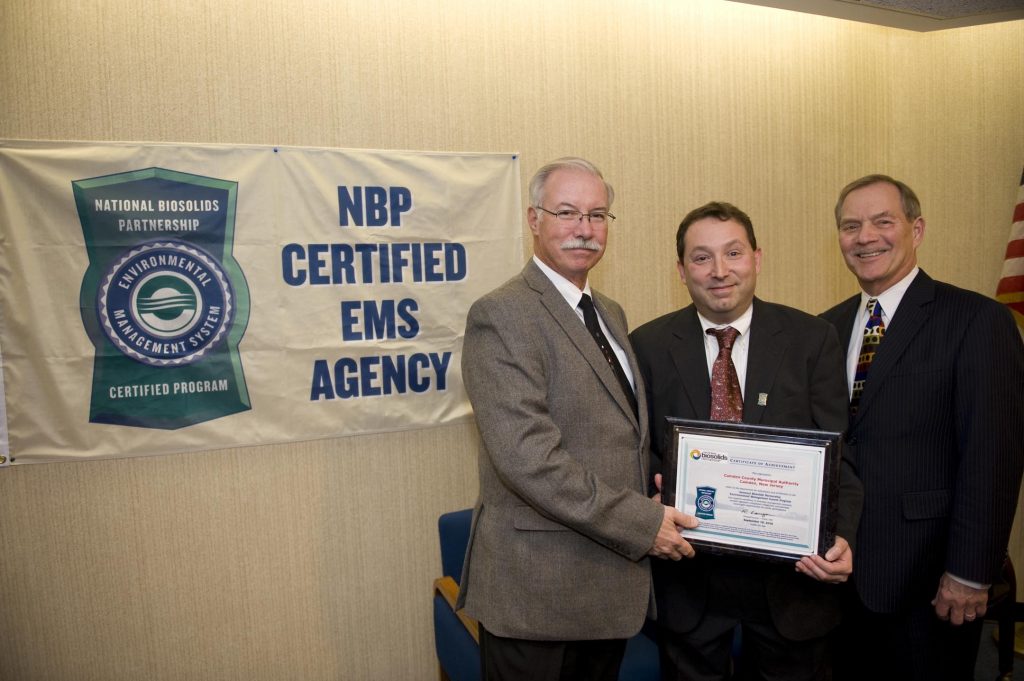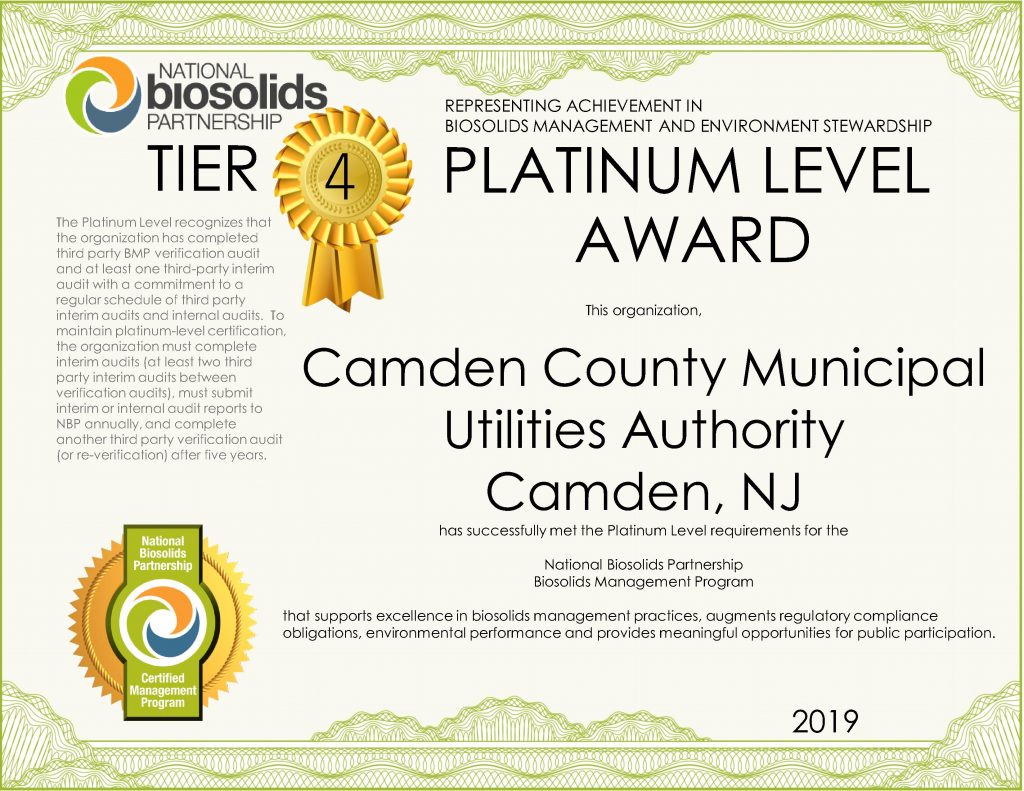An Environmental Management System (EMS) is a framework that helps an organization achieve its environmental goals through consistent review, evaluation, and improvement of its environmental performance. The program is designed to identify a utility’s most important priorities and then ensure that the utility’s resources are harnessed toward meeting those top priorities and continually improving.
In 2010, the CCMUA became a National Biosolids Partnership (NPB) Certified Environmental Management System Agency in recognition of its commitment to environmental performance and community service. Certification from the National Biosolids Partnership—a joint venture between the United States Environmental Protection Agency, National Association of Clean Water Agencies, and the Water Environment Federation—is a tremendous honor for water and wastewater utilities. At the time of its certification, the CCMUA was the first water or wastewater utility in the State of New Jersey–and only the 31st agency, out of over 14,000 utilities–to receive this prestigious national honor. The CCMUA has since been certified at the Platinum (highest) level.
In general, an Environmental Management System is a management program designed to identify a utility’s most important priorities, and then ensure that the utility’s resources are harnessed toward meeting those top priorities and continually improving performance.
Environmental Management System Scope
The scope of the EMS is: Wastewater treatment, biosolids production and community service at the Delaware #1 Water Pollution Control Facility, including pretreatment, wastewater treatment, effluent discharge, biosolids preparation and drying, biosolids transportation and use.
Since the CCMUA implemented an Environmental Management System, it has:
- Improved odor control performance by installing approximately $20 million in new odor control equipment and implementing institutional and operational controls to improve performance.
- Reduced operating costs such that the CCMUA’s user rate is actually lower than it was in 1996 after considering the effects of inflation. Specifically, the CCMUA has held its rate during this period while simultaneously improving environmental performance.
- Begun the Long-Term Control Plan well ahead of necessary compliance timing.
- Added 100 acres of Greened Area in Camden for stormwater capture and Brownfield reduction.
- Developed a recycling program for use in local schools. The school district received a recognition for the program from Sustainable Jersey.
- Constructed a combined heat & power plant that will be in service in 2019, leading to increased self-sufficiency in energy generation.
- Worked with the US Water Alliance as an example for initiatives for reducing sewer overflows and safe drinking water.
Documents
Environmental Management System Manual
- Camden County Municipal Utilities Authority Environmental Management System Manual (2018) (PDF)
Slide Presentation on CCMUA Environmental Management System
- Implementing an Environmental Management System (PDF slide show) by Andrew Kricun, PE, Executive Director
EPA Report on EMS Case Studies including CCMUA
- “Environmental Management Systems: Assisting Wastewater and Drinking Water Facilities Achieve Environmental Excellence,” EMS Case Studies in the Public Water Sector, Global Environment & Technology Foundation and the U.S. Environmental Protection Agency Office of Water, 2005 (PDF)
Article in Treatment Plant Operator magazine, featuring CCMUA
2022-2023 Performance
2020 Performance
2019 Performance
2018 Performance
2017 Performance
- CCMUA 2017 Performance Report
- Internal Audit Report (Solids Handling Storage and Transportation) May 18, 2017
2016 Performance
- Internal Audit Report (Communication & Outreach) January 20, 2017
- CCMUA 2016 Performance Report
- ISO 14001 Internal Audit Report: Wastewater Treatment and Solids Generation August 19, 2016
2015 Performance
- CCMUA 2015 Performance Report
- Biosolids EMS Interim Audit Feb 29, 2016
- Internal Audit Report Jan 21, 2016
2014 Performance
2013 Performance
- CCMUA 2013 Performance Report
- Internal Audit Report Jan 14 2014
- Biosolids EMS Interim Audit Dec 23, 2013
- NBP EMS Congratulatory Letter and Certificate Jan 29, 2014
2012 Performance
- CCMUA 2012 Performance Report
- Biosolids EMS Interim Audit Dec 12, 2012
- Internal Audit Report Sept 5 2012
2011 Performance
2010 Performance
- CCMUA 2010 Performance Report
- Audit Report Sep 19 2010
- NBP EMS Certificate (2010)
- NBP EMS Press Release Sep 27 2010
- NBP EMS Congratulatory Letter Sep 27 2010
- WEF EMS Congratulatory Letter Sep 24 2010
- NACWA EMS Congratulatory Letter Sep 24 2010


